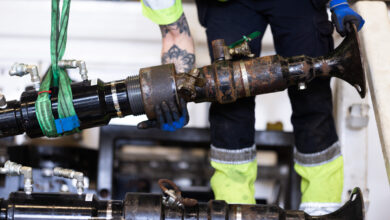Adkins: Oil looking damn good while gas may get a bit ugly

Oil is looking damn good for the next three to five years, said Marshall Adkins, managing director for Raymond James & Associates, at the IADC Drilling Onshore Conference & Exhibition on 20 May in Houston. Gas, on the other hand, may have a tougher time, although he emphasized that it’s not a disaster scenario.
“As many of you know, I’ve been somewhat pessimistic about natural gas prices over the past two or three years, and I’d love to tell you that I’ve changed my strides … but I just don’t see the evidence to support that yet,” he said.
Looking first at the oil sector, Mr Adkins noted that the market seems to care less about inventory and more about global demand, and so far, demand has been growing “way faster than we would’ve thought.”
Although there is currently growing concern about whether global oil demand will hold up, Mr Adkins said that as of now, the IEA forecast of 2% global demand growth for 2010 is very “doable.”
He pointed to annual vehicle sales in China, which has gone from roughly 6 million just five years ago to an estimated 17 million this year. “That’s a lot of consumption, and it puts it in perspective for me as to what’s really happening in the Chinese market,” he said.
On the supply side, growth in non-OPEC supply is scant, while OPEC excess capacity is likely not as high as official OPEC statements, he said. In fact, Mr Adkins believes that many OPEC countries are overstating their production numbers.
“I think we’re at less than 3 million (barrels) a day of excess capacity as we sit here today,” he said. “If we look out over the next two years, I think we are back out of excess capacity in the next 24 months. … If the recovery continues as robustly as it has so far, we’ll probably be out in 18 months. If we go into a double-dip recession … if China slows, Europe slows … then maybe 36 months. But sometime in the next 18 to 36 months, I think we’ll be back at the same level of excess capacity as we saw in mid-’08.”
What happens then? Speculators who popped up in 2008 will likely drive oil prices back above $100/bbl and higher. again.
“Clearing $100-plus, to me, seems a pretty achievable number. I know that shocks a lot of people in light of the collapse we’re seeing going on right now.”
Turning to the natural gas picture, Mr Adkins said he doesn’t see significant price increases. And yet: “I don’t think a sub-$5 gas world is a disaster for the people in this room. I’m actually relatively optimistic about the ability of the rig count to hold, even in the face of sub-$5 gas,” he said.
One of the biggest problems in this sector is that there is a glut of gas, and there will continue to be a glut of gas.
The industry is 10 times more productive per well than it was in 2006, he said. “Just think about that: You’re 10 times more productive for every well you’re putting in the ground. That’s a massive shift.”
More importantly, this kind of efficiency is happening across the board on land drilling, including with the Granite Wash, dolomites and chalks, where horizontal fracturing technology is being applied. “It’s not just a shale phenomenon,” he said.
The percentage of horizontal wells has increased dramatically, with private operators now drilling 50% of their wells horizontally, compared with 20% just nine months ago.
Mr Adkins also looked at growth in gas productivity since September 2009, saying that numbers suggest US gas production could be up by 6 Bcf/day by September 2010.
“Here’s the problem with that: There was only an average 700 gas rigs running that drove that growth rate. Today, we have 950 gas rigs running,” he said, suggesting that the gas glut will only increase.
It’s not all bad news, however, mainly because drilling economics for natural gas have changed. In addition to the advent of efficient horizontal drilling and fracturing techniques, the industry has seen a high-grading of prospects, meaning “we got rid of a lot of the crappy wells we were drilling.”
Additionally, service costs are down dramatically, he said. “Peak to trough, they’re down 40%. Now, they’re going back up, but they’re still down probably 30% from ’08 peaks.”
Drilling efficiencies have also improved, with rigs drilling 20% to 30% faster.
Add it all together and it means that drilling can make economic sense today at $5 gas or less.
Mr Adkins does believe, however, that the gas rig count will begin to deteriorate in the near term. “It’s probably going to fall roughly 200 rigs over 18 months,” he said. There are just under 1,000 gas rig running now, so by the end of 2011, that number should be under 800.
On the other hand, the oil rig count is forecast to increase. “We think that oil, as a percentage of overall drilling, continues to go meaningfully higher,” he said. By the end of 2011, as much as 50% of land rigs could be drilling for oil, out of a forecasted rig count of approximately 1,500 units.
“We’re going to do pretty good as an industry. This is not a disaster scenario. … For a change, I think our business looks pretty good despite a relatively ugly outlook for gas over the next year or two.”




